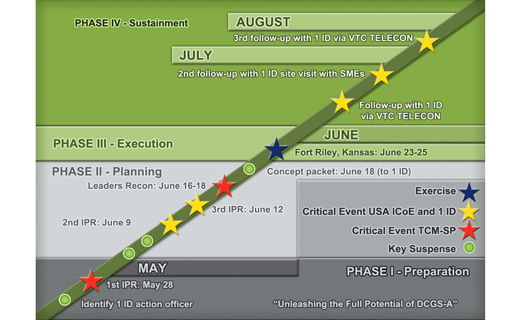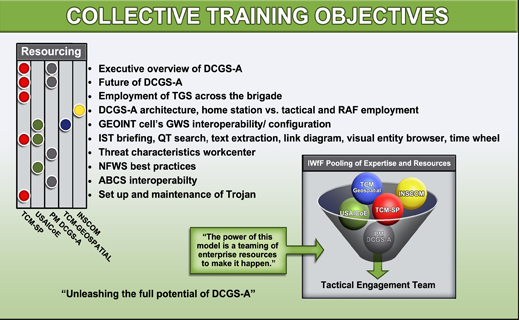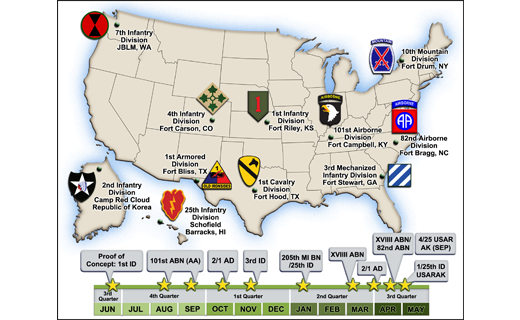Intelligence Center Develops Distributed Common Ground System-Army Tactical-Engagement Teams to Support Mission Command



As the Army implements the new Army operating concept, “win in a complex world,” the U.S. Army Intelligence Center of Excellence (USAICoE) developed the tactical-engagement team (TET) concept to bring Distributed Common Ground System-Army (DCGS-A) subject-matter experts (SMEs) to the operational Soldier in support of mission command.
The TET concept developed by USAICoE and the U.S. Army Training and Doctrine Command (TRADOC) Capability Manager-Sensor Processing (TCM-SP) for DCGS-A is a team of SMEs from across the Intelligence Corps who plan, coordinate and execute training to take leaders and Soldiers beyond simply understanding the functionality of DCGS-A.
The Army operating concept requires intelligence warfighting function (IWfF) training to increasingly focus on employing the DCGS-A weapons system to support expeditionary operations with light and lethal formations capable of deploying quickly.
This new environment is increasingly dominated by the proliferation of technology and rapid information exchange. Now more than ever, intelligence Soldiers are realizing that attaining and maintaining proficiency in the use of key mission-command systems is essential for success.
To that end, USAICoE and TCM-SP (DCGS-A) at Fort Huachuca, AZ, engaged in a deliberate effort with U.S. Army Forces Command (FORSCOM) and U.S. Army Intelligence and Security Command (INSCOM) by establishing a TET to enable intelligence Soldiers to fully employ the DCGS-A weapons system within the context of executing core intelligence tasks. The TET educates Soldiers from an operational-employment perspective focused on interoperability and seamless intelligence in the new operating environment.
TET training begins by focusing the intelligence professional on the tactics, techniques and procedures (TTPs) of employing and putting into action DCGS-A tools that specifically support the commander’s decision-making cycle and processes. The whole idea is command-centric.
TET training
“Current DCGS-A system introduction, fielding and training does not build broad understanding within tactical-level IWfF/medium-weight force (MWF) leaders in the application and establishment of DCGS-A as a system of systems that provides intelligence support to training and operations, which enables mission command.”-unit contact brief, 1st Infantry Division proof of concept
To accomplish this goal, the tactical-engagement concept is designed around the following principles:
- Train intelligence leaders on how to employ the system;
- Train intelligence leaders and Soldiers how DCGS-A enables mission command;
- Show intelligence leaders how to establish the brigade combat team’s intelligence team on the network 24/7;
- Show intelligence leaders and senior trainers one method of training the team to support the commander; and
- Tailor tactical-engagement training to the unit’s needs, then organize, plan and execute based on unit objectives.
Though each engagement is uniquely tailored and is based on unit objectives, the basic principle of tactical-engagement training centers around the unit and its ability to provide intelligence to the tactical commander while employing DCGS-A as its weapon system.
Tactical engagement essentially prompts leaders to look at their formations, honestly assess their capability and determine where they need help. After commanders assess their units’ capabilities and decide where they need support, the TET leadership assembles the SMEs from across the intelligence enterprise to teach, coach and mentor those areas identified by the unit.
How TET began
In April 2014, TCM-SP determined there was a gap in understanding employment and use of the system of systems that gives DCGS-A its true power. The system, not unlike other complex technology advances, requires upfront proficiency from an individual perspective, but also an understanding by leaders of how the system should be employed and what tools it brings to the intelligence community in support of planning for operations, executing current operations and predicatively preparing for future operations – essentially the intelligence cycle during combat operations.
The idea of tactical engagement was to fill the gap between institution and unit training responsibilities by essentially teaching intelligence professionals how to operationally tie in DCSG-A to the Army Battle Command System (ABCS) network and use its tools to conduct intelligence preparation of the battlefield (IPB) in support of the commander’s military decision-making process, a foundational requirement of battle command. Also, the TET would train the importance of collaboration and near-real-time sharing of intelligence with operational partners as staffs fought to attain and maintain a common operational picture that provides the unit holistic and common understanding of the situation.
Realizing the span of this problem, tactical engagement was scoped to focus initial efforts on the 11 active divisions and their intelligence, operations and communications teams (G-2,G-3, G-6), specifically the IWfF and the senior intelligence officer of each formation. After initial concept development, TCM-SP proposed the idea to the Army’s divisional G-2s and asked a unit to step forward and help provide a proof-of-concept training event.
Based on this engagement with the Army’s intelligence leaders, command emphasis/focus and history with DCGS-A, 1st Infantry Division’s G-2, LTC Marc Spinuzzi, volunteered to provide the venue for the proof-of-concept with his entire division IWfF. It was at this point that the TET concept took its first step from idea to action.
Spinuzzi describes the demonstration and impetus for contacting TCM-SP in April 2014: “Our DCGS-A demonstration was not intended to sugarcoat the system – we talked about what it does well and what it doesn’t do so well. The two biggest problems we discussed were training and the DCGS-A interface. While there are plenty of training opportunities available for DCGS-A, we had found that most of them focused on a narrow set of tools. There were several great tools in DCGS-A that simply weren’t being trained anywhere – tools like the Threat Characteristics Workcenter (TCW) and the [Intelligence, Surveillance and Reconnaissance (ISR)] Synchronization Tool (IST).
“The DCGS-A interface was also a common complaint,” Spinuzzi said. “The system simply does not come across as ‘user friendly.’ It isn’t intuitive, so Soldiers often struggle to find the tools they are looking for or to quickly make use of the ones they know. We thought we had a good solution to these problems. We needed to get our Soldiers to talk to someone who could listen to their thoughts and opinions and help adjust the training and the interface.”
TCM-SP saw an opportunity to implement a new vision of “unleashing the full potential of DCGS-A, one tactical formation at a time” and built a team of SMEs to provide the resident knowledge to build confidence and competence in the system. Rather than simply responding by sending a few trainers, as Spinuzzi anticipated, TCM-SP requested a complete list of 1st Infantry Division’s training objectives. Then they put together a team of SMEs drawn from not only TCM-SP but the entire DCGS-A enterprise for a multi-day event at Fort Riley, KS.
Over a 60-day period, the DCGS-A TET held a series of collaborative and interactive planning sessions with 1st Infantry Division’s chain of command and Spinnuzi’s teams. TCM-SP and 1st Infantry Division staff linked each training event to 1st Infantry Division’s training objectives and coordinated with many other organizations, who provided SMEs for the team
Proof of concept
The June 2014 engagement at 1st Infantry Division began with an introduction brief focused on educating commanders and staffs on DCGS-A capabilities. The assembled team of SMEs from the TET consisted of almost 30 people. The team was comprised of individuals from TCM-SP; Program Manager DCGS-A; USAICoE NCO Academy; Training, Doctrine and Support; New-System Training and Integration Directorate; and Department of the Army G-2. SMEs from all over the country came together with one clear objective: build leader and Soldier confidence, understanding and competence of how to successfully employ DCGS-A.
Soldiers and leaders of multiple intelligence military-occupation specialties (MOSs) were trained in a myriad of system tools during a three-day event. Training focused on intelligence production and ABCS interoperability.
Training during the 1st Infantry Division engagement included TCW; DCGS-A architecture; IST; employment of Tactical Ground Station (TGS) across a brigade, Multifunctional Workstation (MFWS) best practices; Geospatial Intelligence (GEOINT) Workstation (GWS) interoperability/configuration; Situation Awareness Geospatially Enabled (SAGE), ABCS/mission-command interoperability; setup and maintenance of Trojan; and establishing a brigade intelligence-sustainment training plan.
Issues identified during the training were corrected on the spot. TET members were able to immediately adjust DCGS-A configurations to allow users to have access to all data sources around the world.
Soldiers and leaders alike were directly connected to experts for each facet of the system and were encouraged to use those connections to further educate themselves and train their Soldiers. Overall, the engagement laid to rest some of the false perceptions of DCGS-A and demonstrated that although the system is not perfect (no system ever will be), it provides a robust capability that when understood, trained and employed properly, will satisfy the commander’s intelligence requirements.
“Key to our success was establishing command emphasis with brigade commanders to provide three uninterrupted and focused days of training, enabling the opportunity to connect our intelligence community across [Fort Riley] and discuss trouble areas, TTPs and lessons-learned in a near-rankless environment,” commented Spinuzzi. “Senior intelligence leaders had a chance to pass on their lessons-learned to junior intelligence Soldiers. Junior intelligence Soldiers provided candid bottom-up feedback. The majority of our after-action report comments were requests for more, which was a great sign.
“TCM-SP brought in a world-class team of experts to address everything from DCGS-A best practices to brigade-level training strategies,” Spinuzzi said. “The tactical engagement was a resounding success.”
Tailored engagement
Throughout the combined planning process with TCM-SP, commanders and units drive the TET’s composition by identifying training requirements as well as gaps in knowledge and capabilities. As such, each TET is organized, planned and executed based on unit-specified objectives, giving it a tailored feel. TCM-SP, in coordination with the unit, builds a unit-specific training strategy that complements existing program-manager functionality training associated with new-equipment training and doctrine, tactics and techniques (DTT). Also, post-DTT, collective-training strategies are established and are nested with FORSCOM G-2 and INSCOM. The entire concept is a building block using existing systems provided by senior intelligence leadership.
TIt holistically looks like this:
- Program manager provides functionality training when equipment is fielding;
- New-Systems Training Division from the USAICoE provides a 90-hour IPB-focused training course to assigned analysts;
- INSCOM through Foundry provides DCGS-A advance-production training to intelligence leaders;
- Tactical engagement provides system-of-systems training specifically focusing on operational employment and interoperability, including focused training on tools or system components;
- Foundry sites provide sustainment training and offer internal collective training venues using Intelligence Electronic Warfare Tactical Proficiency Trainer; and
- Training centers bring it all together by providing an environment that is truly ABCS-centric.
Communicating best practices
The DCGS-A TET facilitates the sharing of lessons-learned, TTPs and best practices throughout the Army. Each engagement provides an opportunity to collect and share Army-wide success stories on system employment, combat-training-center best practices, regionally aligned force best practices and TTPs for decisive action and counterinsurgency missions. Peer networking is another key benefit. Relationships built facilitate continued sharing of ideas between formations long after the engagement is over.
As TET continues to engage the force, the collective knowledge will be socialized across formations and documented for use by the entire force. The TET also provides leave-behind products such as brigade training plans, TTPs, standard operating procedures (SOPs), tactical SOPs and example products to further enable unit success.
Strategy – strategic and tactical
The tactical-engagement strategy seeks to address current DCGS-A challenges at both the strategic and tactical levels:
- Endstate – TET’s goals. Tactical commanders are confident in their S-2’s ability to help them with battlefield visualization: see themselves, see the enemy and see the terrain.
- Soldiers. The unit’s intelligence professionals gain confidence using DCGS-A and improve their ability to complete MOS skill-critical tasks using DCGS-A. They understand the “so what” of producing intelligence products, are able to interoperate with the Army’s ABCS architecture, and are confident and proficient at employing DCGS-A to its full potential to meet the commander’s requirements. Unit intelligence Soldiers also gain a basic understanding of system-troubleshooting skills, thereby reducing the reliance on contract field-support engineer (FSE) support.
- Leaders. The unit’s intelligence leaders understand DCGS-A from a system-of-systems perspective and learn to ask the “right questions” pertaining to employment and intelligence-product development. Also, they learn where to turn for assistance when required and how MOS 35Ts, intelligence-unit maintainers, can assist with technical issues. Lastly, they are confident in the system and competent in its use, enabling them to fully leverage the potential the system was designed to provide a tactical commander.
- Team. The commander’s intelligence team understands the holistic approach to DCGS-A system training. DCGS-A tactical engagements assist the unit’s intelligence team by providing a start point on how to train the intelligence discipline as a team vs. individual MOS skills acting independently. They learn that orchestrating in concert with the other warfighting functions provides a powerful tool for command decisions. Most importantly, through integrating DCGS-A training with the unit’s ABCS, the unit understands how to fight using DCGS-A to support mission command.
Way Ahead
Capitalizing on the momentum, TCM-SP has begun the process of engaging other senior leaders across the Army in an effort to offer similar training. Figure 5 is a snapshot of the way ahead. Units from across the Army are taking advantage of the TET concept.
DCGS-A by design is expeditionary and tailorable. It takes large amounts of data and provides structure to enable an analyst to clearly see through the fog of war. Tactical engagement puts the potential of the weapons system in the hands of the warfighter to assist units in configuring, using and successfully employing DCGS-A in support of mission command.
 email
email print
print